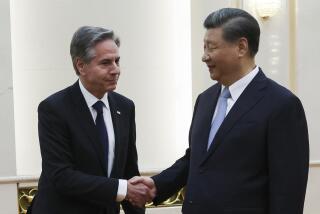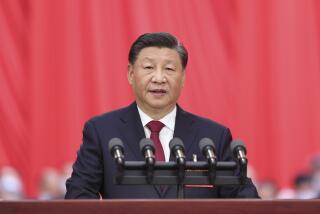China Doesn’t Require a Leap of Business Faith : Trade: Whatever its problems, it offers the world’s most lucrative opportunities.
- Share via
1995 is an “August” leap year in China. While leap years do not necessarily augur turbulent times for the Middle Kingdom, “August” leap years (which feature an extra month on the Chinese calendar) have brought woe with worrisome consistency. In 1900, the Boxer Rebellion triggered bloody foreign reprisals; in 1957, an anti-rightist campaign presaged years of chaos; in 1976, the Tangshan earthquake claimed 200,000 lives and death claimed Mao Tse-tung and Chou En-lai. It is small wonder that the superstitious Chinese look upon 1995 with unease. After three years of dazzling economic success, many in China see cataclysm on the horizon.
The storm clouds seem everywhere to be gathering. Deng Xiaoping is dying and the struggle to succeed him is paralyzing China’s increasingly belligerent leadership and undermining the country’s bid to join the new World Trade Organization. A punishing trade war with the United States also looms. Foreign investors, once China’s most unwavering supporters, now waver over tales of unpaid debts, broken contracts and failing joint ventures. Is China’s economic miracle coming undone?
The pessimists say yes and argue that rampant inflation will be the undoing. Urban inflation hit 27.7% in October. GDP growth remains spectacular (11.5% in 1994), but runaway inflation threatens to devastate the 800 million rural Chinese, who earn only $141 a year. A strict monetary policy aimed at rooting out inflation would, however, mean widespread bankruptcies for state-owned enterprises, which survive on subsidized (and inflationary) government loans.
These enterprises are non-competitive money losers. Responsible for only 48% of output, they account for 54% of jobs and 61% of total fixed investment. Any significant reduction in subsidies would throw millions of workers onto the streets; presumably, political unrest would follow. With 200 million already unemployed or underemployed, this is cause for more than passing concern. But inaction seemingly leads to the same result: As continuing subsidies stoke inflation, peasants and poor city-dwellers will feel the pinch and rebel.
This argument, widely embraced by investors and analysts as well as China’s insecure leaders, is badly flawed. It rests on both a faulty premise and a misunderstanding of China’s recent economic success. The faulty premise is that China is suffering from runaway inflation. It is not. Anomalous price shocks--floods in the south and drought in the north--sent grain prices soaring 60% in 1994. Administrative price controls on key foodstuffs were also lifted early in the year. The inflation rate for non-food goods has been seven to 10 points lower than the inclusive rate all year, and was 17% in October. This might still seem high; but at least 5% of China’s inflation can be traced to an ossified state distribution and marketing system that keeps supply separate from demand.
China’s core inflation rate of about 10%--still high by Western standards--poses little threat to an economy growing by more than 10% a year. Slack labor markets (a brake on wage inflation), improving trade balances and continuing capital inflows will keep inflation in check well into the long-term. For all of its bad press, China still offers the world’s most lucrative direct investment opportunities.
The misunderstanding relates to the state sector’s impact on the thriving private sector. A “stable” state sector does not sustain the private sector. It constrains it by distorting incentives, misallocating capital and siphoning off labor.
Genuine reform will not beget trouble; it will spur new growth. As inefficient state enterprises are pushed into bankruptcy, capital will flow into an efficient private sector. Cheaper credit will allow producers to expand output and employment. The end of macroeconomic uncertainty will attract more foreign investors.
This means that China’s economic performance is more likely to improve than worsen, no matter what the bureaucrats do. Neither inflation nor state-sector reform nor political infighting can derail the engine of Chinese growth. (A trade war is another story and something both the United States and China must avoid). This leap year is more likely to bring promise than peril, for China’s future is still unspeakably bright.
More to Read
Sign up for Essential California
The most important California stories and recommendations in your inbox every morning.
You may occasionally receive promotional content from the Los Angeles Times.












